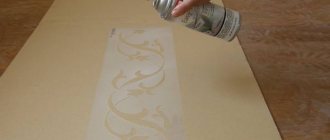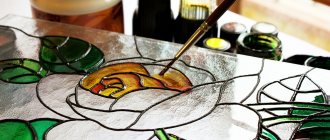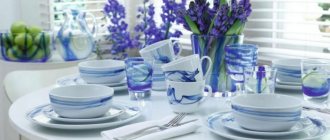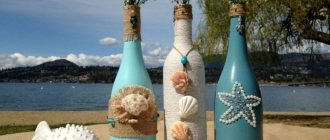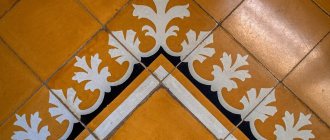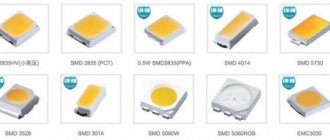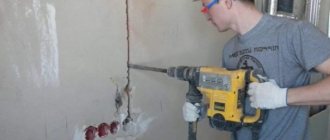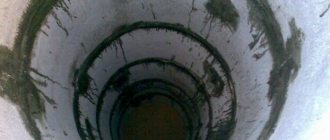Since ancient times, people have paid attention to the beauty of nature. The desire to decorate one’s primitive life and make it cozy led to the fact that the home began to be decorated with various natural elements. It was the skin of an animal underfoot, drawings on the wall, colored stones, shining metal and much more. Centuries later they began to paint plates, spoons, and bowls. Each region had its own types of tableware painting.
The emergence of Khokhloma painting
Near the old Trans-Volga forests near the Uzola River there are Russian villages - Khryaschi, Kuligino, Semino, Novopokrovskoye, Khokhloma. The dishes, painted with various gilded designs, originate from here.
Unfortunately, it is not possible to accurately establish the beginning of the appearance of Khokhloma painting. After all, all the dishes were made of wood, quickly wore out, were thrown away or thrown into the oven, like an ordinary log.
Products from the 19th century have survived to this day. But, judging by historical papers, the fishery arose in the 17th century.
The unique Khokhloma technique - painting on a gold base with black paint and cinnabar - is found in ancient Russian art.
Khokhloma as a tradition. History of origin
Let's get to know her
According to an old legend, in Muscovy there lived a skilled master - an icon painter who loved his work and enjoyed special honor from the Tsar himself. However, one day he decided to escape into the thicket of the forest to freedom and engage in art there, which absorbed all the beauty of the Russian land. People came to see his works from different parts of the world. In the end, word reached the king, after which an order was issued to the archers to catch the master and bring him to the palace. Only the master found out about this order, revealed the secret of his craft to his neighbors, set fire to his hut and ran away. No one has seen this master since then, and Khokhloma began to sparkle with new bright, fire-like colors.
Khokhloma painting was considered a symbol of fire, and the color of execution was associated with something beautiful, beautiful, and was also identified with the blush of the sun and its glow, that is, with the color of the sky and celestial phenomenon. This type of painting seemed to be permeated with rays of light, and the product itself emitted light from a golden radiance, since, peering at it, wonderful visions appeared before the eyes of the caretaker.
On large objects, dishes and bowls, a square or rhombus with softly rounded corners was drawn around the socket. Using cylindrical shaped salt shakers or salt shakers, craftsmen created drawings of shoots rising from the ground. The lower the height of the product, the more intense the movement of the wave of the ornament running around it. The higher the product, the steeper the wave of the spreading branch. The entire surface of the object was harmoniously filled with ornaments. Festive dishes were decorated more intricately and magnificently. The Khokhloma fishery reached its peak in the 18th century. At this time, two types of writing develop: top and background. Horse painting was done with plastic strokes on the tinned surface of the dishes, creating a magnificent openwork pattern. A classic example of “mountain” writing is “grass.” “Background” painting was characterized by the use of a black or red background, while the design itself remained golden. But such a color scheme did not immediately appear in Khokhloma painting. It has undergone enormous changes, becoming more laconic and solemn over the years. The whitewash, which created the impression of a three-dimensional form, disappeared, and the range of colors was limited. If earlier craftsmen used white, blue, light blue, pink, green and brown paints, then gradually red, black and gold became the main colors of the ornament. This limitation was caused not only by the fact that these paints did not burn out in the oven during hardening, but also by the fact that artists preferred a combination of these colors, primarily due to their special decorative qualities. As mentioned above, in Khokhloma painting there were two types of writing: “background” and “mountain”.
In “high” writing, the master applies a design with black or red paint to a gold or silver background of the product. Here we can distinguish three types of ornament: “grass” painting, “leaf” or “berry” painting, “gingerbread” or “saffron milk cap” painting. “Grass painting” is reminiscent of familiar and familiar grasses to everyone from childhood: sedge, white grass, meadow grass. This is perhaps the most ancient type of painting. It is painted with curls, various strokes, small berries or spikelets on a silver background. “Herbal” drawing has always been popular among Khokhloma painting masters. With great love they painted this design with a brush, sometimes collecting it in dense bushes, sometimes scattering them over the surface of the product. The techniques for painting floral patterns are so varied that amazing motifs emerge from the master’s brush. They are twisted into peculiar elements, the combination of which creates many combinations. From individual blades of grass, artists paint their favorite motif of a rooster or hen, which sits on a tree and pecks berries from it.
A letter in which, in addition to grass, masters include leaves, berries and flowers, is called “under a leaf” or “under a berry.” These paintings differ from “grass” in larger strokes, forming the shape of oval leaves, round berries, left with a poke of the brush. Folk craftsmen take their motifs by stylizing plant forms. Therefore, it is not surprising that on the products of Khokhloma craftsmen we see flowers, daisies, bells, leaves of grapes, strawberries, currants, gooseberries, and cranberries. The basis of the leaf painting is made up of pointed or rounded leaves, connected in groups of three or five, and berries arranged in groups near a flexible stem. When painting large surfaces, larger motifs are used - cherries, strawberries, gooseberries, grapes. This painting has great decorative potential. Compared to “grass” it is more colorful. For example, if in “grass” painting they use mainly black and red colors, then in “leaf” or “berry” painting, masters paint leaves in green, as well as in combination with brown and yellow. These paintings are enriched with grass patterns, which are painted in such compositions with green, red, and brown paints. Another unique type of painting belongs to the riding letter - “gingerbread” or “saffron milk cap”. This is a geometric figure, most often inscribed in a square or rhombus, and in the middle of the rectangle there is a “big camelina” - the sun. Gingerbread paintings are simpler and more conventional than herbal ones; when you look closely at them, it seems that the Sun, with its rays curled in a circle, is in constant motion. In “background” writing, two types of ornament are distinguished: – painting “under the background” and painting “kudrinu”. Painting “under the background,” as already noted, begins with drawing a line of a stem with leaves and flowers, and sometimes with images of birds or fish. Then the background is painted on with paint, most often black. The details of large motifs are drawn on a golden background. On top of the painted background, with the tip of the brush, “herbal notes” are made - rhythmic strokes along the main stem; berries and small flowers are “sticked” with a poke of the brush. “Gold” shines through in this type of writing only in the silhouettes of leaves, in large forms of flowers, in the silhouettes of fairy-tale birds that Khokhloma masters love to paint. Painting “under the background” is a much more labor-intensive process and not every master can cope with such work. Products with such painting were usually intended for gifts, and, as a rule, were made to order and were valued higher. A type of “background” painting is “kudrina”. It is distinguished by a stylized image of leaves, flowers, and curls. The space not occupied by them is painted over, and the golden branches look impressive against a bright red or black background. “Kudrina” got its name from the golden curly curls, the lines of which form bizarre patterned shapes of leaves, flowers and fruits. The Kudrin painting resembles a carpet.
Features of Khokhloma painting
Craftsmen have their own secret on how to “golden” kitchen utensils. A simple method of coating dishes with gold has survived to this day:
- the dishes were thoroughly rubbed with tin powder;
- covered with drying oil;
- heated in an oven;
- under the influence of high temperature, the drying oil turned yellow, the tin was visible through it, and the effect of gold was obtained.
It is believed that this method of painting dishes belongs to the Old Believers. Previously, in remote villages there were many fugitives who suffered persecution for the “old faith.” Among them were masters of icon painting and book miniatures.
Painted pussy bowl
How long can Khokhloma dishes last? And which was the most common?
There are exhibits in the collections of major museums. They were bought from the population, that is, they were already used in everyday life. People either made them themselves or bought them, but specifically for use - cereals were poured into cups, hot cabbage soup and salads were served in bowls to the table. If these large museums now buy works from us, they immediately place them in the collection, without using them in everyday life.
Today it is difficult to determine how long the products of this craft can last, because they are being replaced - like the products of all trades in general - by cheap materials. Nowadays, no one takes a painted cup out into nature or on a hike, but buys disposable tableware in the store to put in a bag and throw away after a picnic. We can say that today crafts have some kind of boundary between their use and works as works of art.
However, in the old days, practical and inexpensive painted tableware was everyday use. We even, I remember, had a “pussy bowl” where they poured milk for her. Porcelain was expensive then, and there were no plastic dishes either.
I remember that during my childhood they used mainly wooden products, that is, what we did was what we used: spoons, small cups, bowls, bowls. They were called differently, depending on the shape. If the turner just carved out a cup, that means it is a cup. If it resembles a clay bowl or is intended for something, that’s what it was called: bowl, candy, casket. Each product had a specific purpose.
Was there a division of labor? Could one family, for example, make dishes and paint them, or was this clearly separated?
If I am an artist, but do not know how to sharpen, then I cooperate with a neighbor who is a turner: he makes a blank, cuts out the product and gives it to me so that I can do further processing and painting. If this happened among members of the same family, then it was even more profitable.
Some families built dyehouses; for example, a neighbor who had no paint or varnish came to them to paint, and she was paid for the work. And as a result, artels and promartels appeared.
Khokhloma patterns
Inexpensive utensils for everyday use can be recognized immediately. It was made with special stamps from a raincoat mushroom or a felt piece of fabric; the patterns turned out to be elementary, but did not lose their beauty. On such products numerous diamonds, spirals and leaves are visible.
More expensive dishes were painted more skillfully. The compositions were created by hand with a brush. There is much more work involved. The masters drew:
- berries (raspberries, strawberries, rowan);
- fantastic birds;
- flowers (cornflowers, clover, violets).
This is how painted spoons, plates, mugs and much more were created.
The main colors characteristic of Khokhloma painting are red (cinnabar) and black (soot). But to make the drawing come to life and bloom, brown, green, blue, orange and yellow shades were added to the products.
Additional colors
Green, brown and yellow are the colors that really help to enliven an image and add dynamics to it. White, orange, blue and emerald are acceptable, but they are less common. Although in modern products released these days, such colors are penetrating more and more. In fact, factories that produce Khokhloma-painted products are trying to diversify their range, going beyond the ideas of Khokhloma, which can be quite narrow among consumers.
If you see a work that uses more than just primary colors, this does not mean that some unshakable canonicity has been violated. There is nothing disruptive about the introduction of other colors: the craft could not have developed if the craftsmen used only tricolor and nothing else. But the artistic image of Khokhloma in the mass consciousness is, whatever one may say, black, red and gold - a fiery triad of colors of happiness.
Educational video about the production and painting of Khokhloma.
Types of painting
Gradually, from household items, Khokhloma products became souvenir gifts or decorations, and not cheap ones at that.
There are main types of tableware painting:
- “Horse” - the main composition - criul - is superimposed on a silver background. Next, droplets, tendrils, and curls are added to it in red and black.
- “Under the background” - first, the silhouette of the ornament is drawn, and the background is filled with black paint.
There can be a variety of types of ornaments on the dishes:
- “Grass” - the emphasis is on drawing small and large blades of grass.
- “Gingerbread” - inside the masterpiece there is a drawn geometric figure. It can be a rhombus, a square, a circle. It is painted with berries, flowers and grass.
- “Kudrina” - a design in the form of golden leaves and flowers in the style of curls is applied to a red or black base.
Khokhloma is an amazing work of art, despite the dark colors, it emanates warmth and joy.
↑ Sequence of drawing the Mezen swan
Figure 12 helps students quickly remember the sequence of drawing a swan:
- we determine the height of the swan figure and draw a horizontal line in the middle (we draw all the lines very thin, since these are construction lines, and are removed at the end of the work);
- draw a circle at the bottom and draw a vertical line to the left of the circle;
- from the upper horizontal line, touching the vertical line, we enter the circle with a large arc;
- from the same point we draw another arc, but now it lies on a circle, this is the neck of a swan;
- on the left, just above the middle of the circle, draw a small arc, this will define the body of the swan;
- draw the head, it looks like the letter “g”;
- We remove all construction lines and start working with paints. Red-brown: head, neck, body. The tail is painted black. It is drawn from bottom to top with a thin curved line with a brush applied at the end of the line. Small lines of “feathers” are drawn from the main line and end with brackets. Small brackets are drawn on the swan's chest - “feathers”. At the bottom of the body there are black legs in the form of droplets.
History of Zhostovo painting
Another famous type of tableware painting is Zhostovo painting. It is famous for the fact that for almost two centuries they have been decorating one thing - this tray. The village of Zhostovo is located in the Mytishchensky district near Moscow.
In the 18th century, in the Urals, where the Demidov metallurgical plants were built (Nizhny Tagil, Verkh-Neyvinsk, Nevyansk), a craft arose - painted metal trays.
The birth of such a fishery near Moscow was caused by several important factors:
- The Russian serf master Khudoyarov discovered a recipe for “crystal” varnish; it did not crack on copper, wood and iron.
- Start of production in St. Petersburg of unusually shaped trays with interesting designs.
- Opening of F. N. Vishnyakov’s workshops in Zhostovo in the 1820s. Here they produced varnished and painted papier-mâché items: trays, boxes, snuff boxes, boxes, and vintage boxes.
The products were made in villages near Moscow - Troitsky, Novoseltsev, Ostashkov. In the village of Zhostovo alone there were 22 workshops. The items were very beautiful. They depicted landscapes, winter threesomes of horses, summer walks, and tea parties at the table. But, unfortunately, these gizmos turned out to be fragile and impractical.
Khokhloma was originally a craft, and then it became art
The famous Russian writer Melnikov-Pechersky says in his novel “In the Forests and on the Mountains” that the manufacture of wooden utensils was one of the main crafts in the Volga region and the entire Nizhny Novgorod region.
What is this connected with? Firstly, if we talk about crafts in the Nizhny Novgorod region as a whole, then each region has its own centers. For example, in Gorodets this is Gorodets painting, Gorodets gold embroidery, Zhbannikov clay toy; in Chkalovsk - Chkalov guipure and many others.
If we talk about Khokhloma painting, then it is practiced in two regions bordering each other - Koverninsky and Semenovsky, where for a long time they were engaged in the manufacture of wooden utensils and painted using the Khokhloma technique with gilding and the use of floral ornaments. To date, these two centers have remained the same, having undergone some changes in structure. In the Koverninsky district there used to be a huge factory “ Khokhloma Artist ”, employing more than 1000 people; today it is not working. There is also a large production facility in Semenov, where the Khokhloma painting factory is located. “Khokhloma” predominates in the name of both enterprises, because it is the name of the fishery.
Now I’ll explain a little why in our places they were engaged in this production. The year is long, agricultural production occupies only the spring-summer-autumn period, winter is inactive, so we need to do something. People also needed additional income for their families: there was nothing to eat. Therefore, initially it was a craft; it became an art only later.
Until 1961, we had artels and promartels, which in the winter were engaged in the manufacture of dishes, and in the summer all the artists were employed at a state enterprise, where artists and craftsmen worked in production all year round. They were distracted by agricultural work only occasionally by invitation - they went to help collect potatoes or prepare hay.
In fact, in a remote area of the Nizhny Novgorod region, thousands of people were involved in the fishery: some sharpened, others cut, others prepared, others painted, and some sold these products. All stages were very streamlined. And there was also sales, because the Soviet Union was huge.
Why did the tradition of creating special painted dishes appear in Khokhloma, and how did it develop?
Why in Khokhloma? In our country, more than 40 villages in the Koverninsky district alone were engaged in the production of Khokhloma painting. We used cheap materials at hand. The Koverninsky and Semenovsky districts are forested areas, so wood was chosen as a material for fishing. For example, linden is a soft material that can be processed both in carving and turning. In general, I cover the entire fishery, but the Koverninsky district is closer to me, because I know it better than anyone: I lived and grew up there, I know all the specifics. Almost the entire region was engaged in the manufacture of products: someone cut spoons, someone painted them, someone bought them and went to sell them - this was the most profitable way. Let us remember that the season for earning money is spring-summer-autumn; for the winter it was necessary to find income somewhere to buy food and clothes.
The entire neighborhood could do part-time work, but they still went to one place to sell their products. Khokhloma was a trading village. Whoever had a horse carried the products for sale to Kostroma, but mostly they carried them on sleds to Khokhloma.
Many art historians claim (and even document) that the technique of making Khokhloma dishes with gilding of wood came from icon painting. Perhaps this is so, because gilding of wood in our area predominates in icon painting. Most likely, some stage in the technology of Khokhloma painting was taken from blanks of boards for painting icons.
In your opinion, in what year did the Khokhloma painting craft emerge?
In the 16th–17th centuries. This is confirmed by art historical search works and documents. It’s hard to say exactly the year. In 1991, the 300th anniversary of Khokhloma was celebrated, although, of course, there is no specific date that it was on this day that they began to paint Khokhloma.
Is it possible to name the place where the fishery originated?
There was the village of Khokhloma, which still exists on the territory of the Koverninsky district. In general, the name of any craft is given by the place where it comes from: Dymka - Dymkovo toy, Zhostovo - Zhostovo trays. But it cannot be said that the masters were only from this village; rather, from the district of villages around Khokhloma. And Khokhloma was a trading village where Thursday bazaars were held. When they didn’t have a name for the painting technology, they said: “Where are we bringing it from?” - from Khokhloma, from Zhostov, from Gzhel. As a result, the type of fishing determined the name of the place from which it diverged.
The appearance of Zhostovo iron trays
Osip, the son of Philip Vishnyakov, decided not to make papier-mâché anymore, but took up the production of iron trays. The demand for trays was just increasing. They were used both for interior decoration and for their intended purpose. Zhostovo trays were seen in drinking establishments, famous Moscow tea houses, taverns, hotels and merchant houses. The collections of Spanish and British kings can boast of the presence of Zhostovo trays.
Demand creates supply, and in 1960 the Zhostovo painting factory was founded.
↑ Composition in the strip
After we have become acquainted with all the options for horses, deer, birds, ducks, swans, and examples of the geometric ornament of the frieze composition of Mezen painting, we move on to the striped composition.
In Figure 14, the composition in the strip is symmetrical and enclosed in red horizontal stripes.
In the center is the tree of life, and symmetrically to it are horses, rearing up and running with arched necks and raised manes. How beautiful and easy they are to run! In the upper part of the strip, proud, busty swans with bushy tails float silently.
Wavy lines, dashes, curls, crosses, and stars filled all the remaining space, creating the impression of a whirlwind from fast running horses.
Secrets of mastery
Observing the long and painstaking process, you can see how the craftsmen still follow the ancient technique.
- Zamalevok. The basis of the future pattern. Sketches of the future drawing are made on the prepared surface with diluted paint.
- Tanezhka. Colored shadows are applied with translucent paints. A visible volume of flowers is created and shady areas of plants appear.
- Gasket in color. This is the most important stage of Zhostovo layer-by-layer painting. The appearance of the bouquet is formed, the entire composition is lightened or darkened, and important small details are determined.
- Glare. Thanks to this action, volume and light appear, the set of features and mood are well conveyed.
- Drawing. The final part of the work on the image. The artist applies small but significant details by hand.
- Binding. The bouquet seems to extend under the background of the product. Thin stems and tendrils magically emerge into a single whole and merge with the background.
- Cleaning the edges of the tray. The side of the tray is decorated with all kinds of patterns. Without this, the work will seem unfinished.
- Mirror shine. Using chalk powder, rub the tray with your palms until it shines, then rub it with paraffin, this makes the product shine even more.
Zhostovo trays have existed for many years, but among them there is not one similar to the other.
↑ Composition in a square
The composition, which is shown on the left in Figure 15, is enclosed in a square. Its center with red spots involuntarily catches the eye, and, looking closely, one can already determine that these are depicted easily running horses, tightly pressed against each other with their arched necks. And if you look closely, you can see that the red spots of the horses all together also make up a square. And from this square, resulting in the center, thin, slender, curly legs and “broom” tails of running horses spread out on all four sides of the next large square.
Between the horses' legs are depicted Christmas trees, spirals, crosses, and stars, creating a feeling of movement. And finally, on all four sides of the largest square are friezes with geometric designs, the friezes consist of triangles in which images of wavy lines, representing water, and small stems with curls, representing trees, alternate. The entire composition is illuminated by four “suns”, which are located at the corners of a large square and consist of a circle and curls extending from it.
The composition, which is located on the right (see ibid.), contains several smaller squares in a large square. The central square is divided into four more squares, which contain black crosses and brackets in the corners. The red lines of the sides of the squares are framed by a black wavy line. Inside the large square, ducks float silently.
Both compositions amaze with their beauty and originality.
Features of the painting
The background is usually black, in rare cases red, blue or green. The artist paints several trays at once.
The main focus is a floral bouquet, in which small wildflowers and large garden flowers are alternately drawn.
Patterns are drawn with gold powder diluted in transparent varnish or turpentine, or gulfabra - white paint mixed with varnish, sprinkled with aluminum powder.
According to their meaning, trays are divided into two groups: for interior decoration and for household purposes.
Wall painting using acrylic paints
You need to prepare the following materials:
- container that will be needed for water;
- brushes of various sizes;
- acrylic paint of the colors that will be used in painting;
- roller (it will be useful when painting large areas with one color);
- a simple pencil;
- ruler
The first thing you need to do is decide what the drawing will be. Moreover, in addition to the stylistic decisions of the room, this should also be influenced by other factors, such as personal preferences, because the main thing is that the owners of the house like the design.
Next, the work is carried out in stages.
Prime and putty the wall and paint it in the color that was chosen for the background of the painting. Using a cage, carefully transfer the selected design to the wall. To do this, first the drawing must be divided into small cells on paper, and then transferred from the sketch to the wall on a scale, that is, proportionally enlarged.
When transferring a drawing, it is best to use a simple pencil, since this will make it easier to remove all unnecessary lines. After drawing the drawing, you can safely remove all the grid lines and start coloring the picture.
Curtains for the kitchen - 120 real photos of new designs. Options for the ideal combination of modern curtains in the kitchen interiorHow to diversify your home interior: DIY decor and beautiful design ideas
- How to hang curtains - step-by-step instructions with photo examples and recommendations. Exclusive curtain design solutions from experienced craftswomen
To obtain interesting colors, acrylic paints can be mixed, white paint or water added to them. If we talk about consistency, it should resemble low-fat sour cream. If you make it too liquid, there is a risk of dripping off the wall.
First of all, paint should be applied to all large areas and only then to small details and the boundaries of transitions between colors.
When completing the work, it is important to wait until the paint has dried completely, after which the artistic wall painting must be covered with acrylic varnish. This will increase the resistance of the new decorative element to ultraviolet radiation and significantly increase wear resistance.
Remember when choosing a pattern for painting that such a wall will definitely become the semantic center of the interior, so it is important that it does not suppress or dominate, but only decorates the room.
Gorodets painting
Refers to one of the Russian types of tableware painting. Gorodets painting originates in the 19th century near the town of Gorodets in the Nizhnegorsky Trans-Volga region, on the left bank of the Volga. This is an ancient Russian fortress city. It all started with spinning wheels, the special feature of which was the bottom and comb.
Carriages, ladies, horsemen, soldiers, dogs - all this decorated the bottom of the spinning wheels. The figurines were cut out of a different type of wood and inserted into the corresponding hole.
Gorodets painting took 50 years to form. Children's gurneys, chairs, and boxes were painted. The peak of the fishery development occurred in 1990.
Vyatka wood painting
The folk craft that arose in the Vyatka province, painting chests on wood, made another contribution to the development of applied creativity. Simple and uncomplicated, as if drawn by a child’s hand, but there is a deep meaning hidden behind it.
Most of the patterns of traditional Vyatka painting have a symbolic meaning for the Slavs. Thus, the circle is a sign of the sun and life, the lion is courage, the birds are good news, and the image of the Duckhorse (the horse of the main ancient Slavic sun god) was applied as a talisman.
In the painting process, the masters used hare's feet and chases (wooden sticks with different patterns carved on the ends). At first, the chest was covered with a special glue, which was made from sheep skin. The design was immediately applied, and another layer of glue was applied on top of it.
Vyatka painting was applied to doors, pillars, and wooden partitions. It happened that craftsmen painted several chests at once, repeating the pattern each time. They folded one into another, according to the principle of a Russian nesting doll.
Motives for painting
The most common elements of Gorodets painting are flowers and animals. Such images exude comfort and peace.
Painted spoons, furniture and dishes in the joyful Gorodets style refreshed and enlivened the interior.
Flower painting is the simplest to perform. There are several types of ornament:
- “Bouquet” - applied symmetrically, present mainly on dishes or cutting boards.
- “Garland” - one or two flowers are located in the center, from which smaller flowers and leaves spread in all directions. Bread bins, dishes, and boxes are painted with this pattern.
- “Rhombus” is a type of garland. There is a flower or several in the center, and the leaves and buds become smaller as they approach the tops of the diamond. And they are located on the imaginary edges of the figure. Such images were used to decorate chests, benches, and cabinets.
- “Flower stripe” is a relic from the days of spinning wheels. This is a repeating ribbon pattern of flowers of the same size, diluted with leaves. Decorate voluminous products.
- "Wreath" - similar to a "flower stripe". The difference is that it closes around the edges of the lid or dish.
In the floral painting there are images of a bird and a horse. They are usually drawn inside a flower garland. Elements of Gorodets painting found their place in large things: panels, sleighs, dishes and boxes.
The images can be very different: dashing horsemen, scenes with tea drinking, beautiful birds, pretty girls with dogs, exotic lions and leopards. The most common type is a proud horse or a warlike rooster.
Contours on dishes
Painting objects with dots has its own sequence in work. To learn how to make beautiful things using this technique, we will conduct a short master class and at the end we will provide several pattern diagrams.
So, first of all, we select the surface that we will paint.
Usually they paint dishes, bottles, cups, plates, boxes, figures, plastic surfaces of computer accessories, keyboards and mice, laptop covers, leather surfaces of passport covers and so on.
Before starting work, the surface must be degreased with a cotton swab containing alcohol or ordinary wet wipes. It is most convenient to work with glass , because on the reverse side you can attach a sketch of a drawing on paper and draw along the lines.
For example, MK "Painting glasses for a wedding."
We will need ordinary glasses, tracing paper, a pen, cotton pads and swabs, contour paint for glass and ceramics.
A pattern is drawn on tracing paper and secured to the inside of the walls with water or tape. Apply drops along the contours of the pattern.
Article on the topic: Openwork blouse with knitting needles: diagrams and description of raglan with photos and videos
You can draw arbitrarily on opaque surfaces, and in order to achieve the correct geometric shapes, you need to carefully draw lines manually or using stencils, cutting out the desired patterns from paper, be it a straight line or a bend, and attaching them with tape. Now you can paint along the edges.
If your product will have patterns with repeating fragments, then the use of stencils and templates is mandatory; prepare the necessary forms in advance.
Spot painting with contours can be combined with lines and other ready-made designs. Cover the entire space or just some part of the item. Frame it with a frame, make a background for a central item, or give it volume.
Drawing errors are corrected with cotton pads, swabs moistened with alcohol or wet wipes.
History of Gzhel
One of the ancient pottery districts includes about 30 villages. It's called Gzhel. It is located near Moscow near the Gzhelka River. Rich deposits of clay were discovered in these places.
Gzhel was mentioned for the first time in written documents dating back to 1339. It was a profitable volost and was the property of princes and kings.
In the 18th century, Gzhel became a Russian center for majolica production. A century later, Gzhel began producing semi-faience, painted with cobalt and covered with a transparent glaze. Closer to the 20th century, Gzhel craftsmen made masterpieces from fine earthenware and porcelain, decorating it with floral and geometric patterns.
It’s okay if life has passed brightly and there is something to remember
Now everyone, especially young people, have switched to computers. We, in fact, everyone who works in an office, who studies in educational institutions , does not write anything by hand. In my opinion, when a person writes with his hand, writes something in beautiful handwriting, his brain works differently, he develops creatively, there is even something spiritual in it. When we deprive ourselves of this , we develop little. What do you think about it ?
When we were in 1st, 2nd and 3rd grade, we wrote with a pen with pressure. This is the same thing that we use in Khokhloma painting. Using a brush, draw a thin line from a thin line through pressure. And after us, from the third grade, everything was changed, even the alphabet. The writing of letters became the same thickness - like bent wire. I don’t even know what the alphabet is now, how it is depicted in the primer and what spelling of letters is required. My association is this: they bent this letter “A” out of aluminum wire, it’s unclear what it looks like, and the whole alphabet goes on.
Of course, I understand that pen writing was abolished in an effort to speed up life: to write quickly, you don’t need to dip your pen in ink. But in this case we are definitely losing something. And it turns out that after running half our life, we suddenly realize it. I didn’t even come up with this - it’s a phrase of many. I looked back and life had passed! It’s still okay if it went well and there is something to remember, there are some achievements. And there are those whose lives are gray and have passed anyway.
I consider my life to be bright: I have represented the fishery many times at various international events abroad, where I told and showed how it is done. There were always crowds of people who loved it. And this is not just to show off: it is an educational program for people who buy Khokhloma painting and appreciate handmade work.
I part with every product made with my own hands as if it were a part of myself. (Of course, if a museum buys, that’s good; if someone else buys, that’s also good). Sometimes you sit down to work and it doesn’t work and that’s it. The hand doesn't work at all. You wash everything, put it aside and take a plate. You draw the same small motif that you wanted to put on a large thing on something else. And then everything works out. And another time you will take the same thing and complete it with rapture from the very beginning to the end. And it feels like you wanted it.
Interviewed by Maxim Petukhov
Subject of the drawing
The painted dishes of Gzhel reflect events occurring in urban and rural life, as well as natural phenomena. The drawings are divided into three main groups:
- Vegetable. Here all the vegetation has a stylized appearance with basic features. You can see berries, blades of grass, cuttings, flowers and leaves.
- Ornamental patterns. Original and stylized drawings in which the association and self-expression of the artist are visible. It is made with ornamental nets - “antennae”, “blades of grass”, “droplets”, “combs” and “pearls”.
- Subject painting. These are sleigh rides, fairs and seasons.
Gzhel is a whole stylistic movement, not just patterns. Used in the production of ceramics, clothing and interior design.
In this miraculous way, Gzhel masterpieces appear “like fairy-tale birds” and fly all over the globe. Therefore, the blue bird in Gzhel is a brand of modern painting.
Main features of the painting:
- surface glazing;
- cool white background;
- ornament in blue and blue tones;
- complex pattern or design in folk style;
- only handmade.
Thanks to hand painting, each product is a work of art. All drawings are unique.
↑ Variants of birds, ducks, swans of Mezen painting
Figure 13 shows various versions of birds, ducks, and swans of Mezen painting.
Here are fancy flying black birds with stripes and checkered patterns, with wings and tails reminiscent of tree branches.
Red “ducks” and “hens” are depicted in the form of an oval with black feathers in the form of dashes and brackets, with small intricate heads.
And finally, beautiful, proud, busty red swans with gorgeous tails. Birds, ducks and swans of Mezen painting are diverse, original and unusual.
